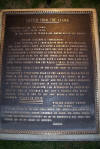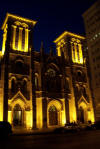OUR TRIP HOME AFTER KATRINA
After viewing our page on Hurricane Katrina, you can imagine and sympathize with our need to see some beauty and/or something resembling restoration. Also, if you know Gerson, he cannot resist the opportunity (even if it is hours and hundreds of miles "nearby") to visit an historic site. As a result, our drive home extended from three days to several days, with lots of history lessons in between.
Many movies have been made about a relatively small, but motivationally large battle at Mission San Antonio de Valero or better known as "The Alamo". Located in San Antonio, Texas, this seemingly insignificant piece of real estate is responsible for encouraging a later battle that not only won the right of Texas to exist separate from Mexico, it also led to the negotiation and surrender of rather "unimportant" tracks of land that have become our beloved New Mexico, Arizona, California, Utah, Nevada and parts of Colorado, Wyoming, Kansas and Oklahoma.
"What happened?" you ask. Well, here is a brief look at history and the battles responsible for yet another fight that has been considered by some to be one of the decisive battles in the world.
|
A Brief History of The Goliad Massacre, the battle at The Alamo and the battle of San Jacinto The Goliad Massacre in 1836 is thought out of all the episodes of the Texas Revolution, the most infamous. Not much of a battle, the real history and inspiration for a future battle came weeks after when approximately 445 prisoners of war (compiled from Goliad and nearby skirmishes) were systematically marched out from camp and slaughtered by well-formed Mexican firing squads (upon the orders of General Antonio Lopez de Santa Anna). During this same time frame, General Santa Anna led an army of over 4000 Mexican soldiers on a northern march. On February 23, 1836, Santa Anna's army reached one of several hotbeds of rebellion - San Antonio. With approximately 200 men, Colonel Jim Bowie (along with such notables as Davy Crockett and Colonel William Travis) stood against the 13-day siege until finally, the last man fell. Within a couple months, Santa Anna had effectively slaughtered several contingents of Texas revolutionaries. The impact of the Goliad Massacre and the annihilation at The Alamo were crucial. Until these episodes, Santa Anna's reputation had been that of a cunning and crafty man, rather than a cruel one. These unforgivable acts aroused the fury of the people of Texas, the United States, and even Great Britain and France, thus considerably promoting the success of the Texas Revolution. On April 21, 1836, with the enraging and inspirational knowledge of Goliad's and San Antonio's treacherous defeats, General Sam Houston led his army of 910 men in battle near San Jacinto, Texas. Houston divided his men and the contingent led by Sidney Sherman sprang forward into Santa Anna's line crying the famous words: "Remember the Alamo!" "Remember Goliad!" The battle lasted 18 minutes and resulted in Santa Anna's army being soundly defeated. Expecting to be shown no mercy as he had shown none himself, Santa Anna braced for the worst, or so he thought. Rather than a systematic slaughter of the remaining Mexican army, Houston was instrumental in "encouraging" Santa Anna to relinquish over a million square miles of land to what was later to become an extension of the United States of America. The new territory included New Mexico, Arizona, California, Utah, Nevada and parts of Colorado, Wyoming, Kansas and Oklahoma. Deserving the punishment, Santa Anna lived to see Mexico lose this beautiful land to the United States. Had it not been for the horrific motivation of the
atrocities brought forth by General Santa Anna, much of the United States
might not have existed as it does today, "Measured
by its results, San Jacinto was one of the decisive battles of the world." |
After visiting several historic monuments, we took advantage of the pleasant day and night to tour San Antonio's more famous architectural inhabitants, The Alamo and The Riverwalk. A very nice city, one that treasures its history and incorporates it within its present.
At The Alamo, a plaque was mounted at its entrance with these moving words by a desperate Colonel William Travis, knowing that his life was to be sacrificed for a greater cause he was not yet aware would occur:
" The People of Texas and All Americans in the World...I am besieged, by a thousand or more of the Mexicans under Santa Anna. I have sustained a continual bombardment and cannonade for 24 hours and have not lost a man. The enemy has demanded a surrender at discretion, otherwise, the garrison are to be put to the sword, if the fort is taken. I have answered the demand with a cannot shot and our flag still waves proudly from the walls. I shall never surrender or retreat. Then, I call on you in the name of Liberty, of patriotism and everything dear to the American character, to come to our aid, with all dispatch. The enemy is receiving reinforcements daily and will no doubt increase to three or four thousand in four or five days. If this call is neglected, I am determined to sustain myself as long as possible and die like a soldier who never forgets what is due to his own honor and that of his country - Victory or Death."
Keep in mind, that when Colonel Travis wrote this impassioned letter, he knew of the slaughters and he knew there was no survival after surrender with Santa Anna.
Following our walk back in human history, we decided to take a brief trek back in the earth's history. We stopped off at Big Bend National Park and walked along the sheer walls that create a forbidding natural border with Mexico. A highlight of our time in the park was watching several large and incredibly beautiful Bald Eagles take flight around our truck.
Another day was spent traipsing through historic towns and onto our planned diversion, the Petrified Forest in Arizona. This preserved park is a natural wonder as it is terribly difficult to believe that this immense area was once a lush forest wherein huge trees thrived. The petrified remains of the giant monoliths give us only a glimpse of what this part of the earth looked like millions of years ago...and what changes have occurred, are occurring and will occur over time.
  |
Some of the fine examples of millions of years of petrification |
  |
How much is still buried out of our sight? |
"Petrification" or "silicification" occurs when the trees are covered in volcanic ash or other fine sediment for a long period of time. During this slow process, rain water, filtering through the ashes and thus enriching itself with mineral substances, penetrates each cavity and each void space of the buried woods and crystallizes. As time has passed, the once covered forest has been partially exposed because of erosion and wind scour. A large amount of trees and tree remnants are visible and quickly you begin to ask "How much of the forest is still buried?. Only future generations will know the answer to that query.
With a nice recuperative stop at my father's home in Arizona, we made it to Huntington Beach and we welcomed the sight of our home.
We leave for Brasil on January 25, 2006 and we will continue our journals from South America. We love being home; however, we love traveling. The trick is, to be able to have both at the same time.















